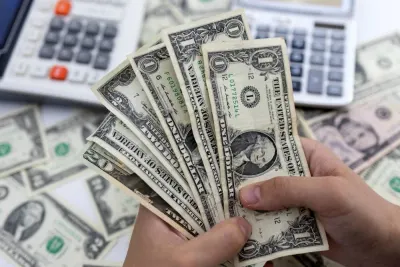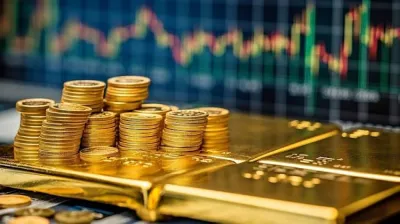A money changer counts US dollar bills at a currency exchange in Manila. Assets invested in the US exchange-traded funds that hedge currency risk grew 18% since September to $21.2bn, according to data.
Bloomberg
As strategists forecast the dollar’s world-beating rally to extend through 2015, US investors are pouring record amounts of cash into funds that protect them against the losing side of the trade.
Assets invested in US exchange-traded funds that hedge currency risk grew 18% since September to $21.2bn, data compiled by Bloomberg show. That’s the biggest quarterly increase since mid-2013.
The funds are proving their worth. While the $4bn WisdomTree Europe Hedged Equity Fund returned 3.1% this year, the $7.4bn iShares MSCI EMU ETF – an unhedged fund that also invests in European stocks – lost 7.7%.
“The dollar is in the beginning of a multi-year strengthening pattern,” Dodd Kittsley, the New York-based head of ETF national accounts and strategy at Deutsche Bank AG’s Deutsche Asset & Wealth Management unit, said in a November 17 phone interview. “Investors are seeing that if you pick the right market but ignore the currency implications, you can still lose.”
The greenback has benefited from a US economy that’s strengthened enough for the Federal Reserve to end its dollar- debasing bond-purchase program and consider the timing of its first interest-rate increase since 2006. That contrasts with Japan and the euro region, where officials are battling deflation with further stimulus policies amid record-low borrowing costs.
The dollar has strengthened at least 3% against its 16 major peers since the end of June. It climbed more than 9% to trade at $1.2436 per euro as of 7:42 am in New York, and jumped 14% to ¥117.90, after touching a seven-year high of ¥118.98 on Thursday.
Deutsche Bank’s Kittsley predicts the dollar will advance to $1.15 per euro in 2015, $1.05 in 2016 and 95 cents by 2017, a level not seen since 2002. Median forecasts of strategists surveyed by Bloomberg anticipate the dollar appreciating to $1.20 per euro and ¥120 by the end of next year.
“With rates so low, the cost of hedging in the developed world is very low, and the benefits have been very positive,” said Jeremy Schwartz, the New York-based director of research at WisdomTree Investments, which manages 12 currency-hedged ETFs with $16.7bn in assets. “As the risk from currency swings increase, it will trip up even the most sophisticated investors. And these offer reprieve.”
The number of US-based exchange-traded funds that guard against currency swings when investing abroad has grown to 36 in 2014 from 13 at the start of last year, while assets rose by 42%, or $8.9bn.
Hedged funds buy stocks, bonds or other assets in another country and then, using forward contracts, take a short position in the local currency when it’s forecast to weaken versus the dollar. Positions are reset monthly to match up with the assets under management within the respective funds.
In Japan, where the benchmark Nikkei 225 Stock Average has risen to a seven-year high even as the yen has tumbled to a seven-year low, the WisdomTree Japan Hedged Equity Fund – the largest currency hedged fund at $12.6bn – has returned 8.6% in 2014. That compares with the $15.4bn iShares MSCI Japan unhedged ETF’s loss of 4.2%.
“It used to be that, if you were betting on a country’s stocks, it meant you also thought the currency was going to gain,” said Michael Jones, chief investment officer in Richmond, Virginia, at RiverFront Investment Group, which manages $4.9bn. “But now, monetary policy – the thing that is catalysing the stocks in these markets to go higher – is also putting pressure on the currencies, making hedging essential.”
RiverFront started buying Japanese hedged ETFs early in 2012, in anticipation of a stronger stock market and weaker yen, Jones said. Since the start of 2012, the yen has fallen 35% versus the dollar, while the WisdomTree Japan Hedged Equity Fund has returned more than 80%.
Just as ignoring rate swings has proven perilous, hedging strategies may backfire when exchange rates don’t move as forecast.
To David Woo, head of global rates and currencies at Bank of America Merrill Lynch in New York, the market’s assuming too fast a pace of dollar appreciation, and the shortage of skeptical bets on the currency leaves investors “very vulnerable to any bad news.”
“The market is too optimistic about the US, when there are still hurdles that have to be climbed,” Woo said. “The US has been stronger than the rest of the world, but the data hasn’t been that great. A lot of the good news has already been priced in.”
That hasn’t stopped hedge funds and other large speculators from boosting futures bets on dollar strength versus eight major peers to a record. The difference in the number of wagers on a gain compared with those on a drop – net longs – was 372,558 on November 11, up from 366,737 a week earlier, according to data from the Washington-based Commodity Futures Trading Commission.
“The path of least resistance is up for the dollar,” said Jennifer Vail, the head of fixed-income research at Minneapolis- based US Bank Wealth Management, which oversees $112bn.



